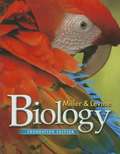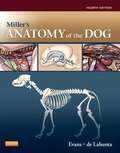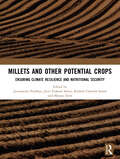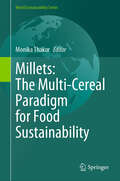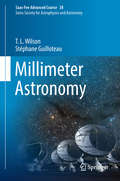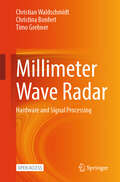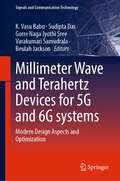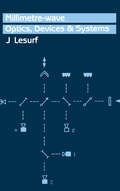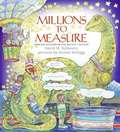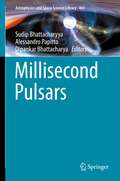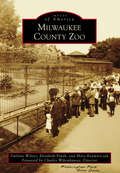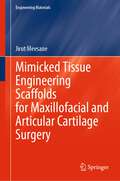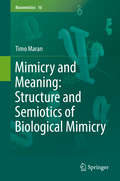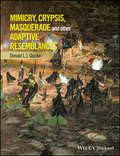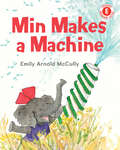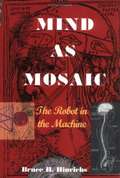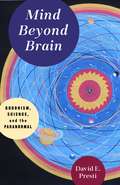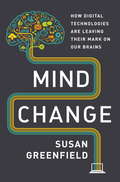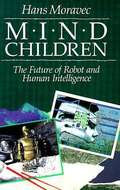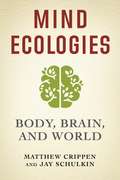- Table View
- List View
Miller and Levine Biology, Foundation Edition
by Kenneth R. Miller Joseph S. LevineA great option for low-level and inclusion classrooms, with digital support on Biology. com. Authors Ken Miller and Joe Levine deliver the same trusted, relevant content in more accessible ways! Written at a lower grade level with a reduced page count, the text offers additional embedded reading support to make biology come alive for struggling learners. Foundations for Learning reading strategies provide the tools to make content accessible for all your students.
Miller's Anatomy of the Dog (Fourth Edition)
by Howard E. Evans Alexander De LahuntaNow in full-color, Miller's Anatomy of the Dog, 4th Edition features unparalleled coverage of canine morphology, with detailed descriptions and vivid illustrations that make intricate details easier to see and understand. Updated content reflects the latest knowledge on development, structure, and function, making this a valuable reference for anatomists, veterinary students, technicians, clinicians, experimentalists, and breeders. It is also useful in specialty fields such as mammalogy, biomechanics, and archaeology. Chapters are logically organized by body system for quick reference. Contributors are expert anatomists who provide the most current information and share their knowledge of particular structures. An introductory chapter includes breed categories from both the American and British Registry Clubs to give you a clearer understanding of dog breeds and how they are determined. NEW! Elaborate, full-color illustrations created by an expert medical illustrator bring canine structures to life and enhance your understanding of their function. New and updated content reflects the most up-to-date nomenclature from the Nomina Anatomica Veterinaria (NAV) - the standard reference for anatomical (zootomical) terminology. Text and bibliographic references from the most current literature allow you to access all primary sources of information for further study and interpretation.
Millet Rhizosphere (Rhizosphere Biology)
by Anil Kumar Sharma Ramesh Namdeo Pudake Maya Kumari Deepak Rameshwar SapkalThis edited volume is the first book that explicitly explains the link between the extraordinarily small-scale microbial processes and the growth and yield attributes of millet crops. This book includes chapters emphasizing on the effects of rhizosphere biology on long-term millet crop management. Millets are a collection of small-grained cereal grasses that are grown for human carbohydrate needs. They are among the oldest crops, mainly divided into two groups: major and small millets based on seed size. Major millets are composed of sorghum (Sorghum bicolor) and pearl millet (Pennisetum glaucum); while small millets are composed of six species that includes finger millet (Eleusine coracana (L.)), little millet (Panicum sumatrense), kodo millet (Paspalum scrobiculatum (L.)), foxtail millet (Setaria italica (L.)), barnyard millet (Echinochloa frumentacea (L.)), and proso millet (Panicum miliaceum (L.). These crops are earlier considered as orphan crops, but recently due to their nutritional values it is gaining the importance. Various reports are published based on role of rhizosphere on growth and health of these crops. The rhizosphere being a dynamic interface among the plant roots and soil microbes provides a number of advantages to the millets too. The soil properties in rhizospheric region are also different as compared to the bulk soil. This book discovers the functional attributes of rhizosphere in promoting the healthy growth of millet crop and achieving higher yield during the changing climatic condition. This book is of interest to university teachers, scientists working in the millets, and policymakers in agricultural departments. Also, the book serves as additional reading material for undergraduate and graduate students of agriculture, biotechnology, microbiology, genetics, and soil science.
Millets and Other Potential Crops: Ensuring Climate Resilience and Nutritional Security
by Jyoti Prakash Sahoo Jyostnarani Pradhan Manasi Dash Kailash Chandra SamalDeeply rooted in indigenous peoples’ culture and traditions, millets (also called ‘nutricereals’ are ancestral crops high in nutritional value. As the global agrifood systems face challenges to feed an ever-growing global population, resilient cereals like millets provide an affordable and nutritious option and help guarantee food security.This book presents the basic principles and practices of millets and other potential crops towards climate resilience and nutritional security. It discuses the role of millets in sustainable agriculture, the medicinal use of foxtail millet, exotic fruits in India, and climate-resilient fruit and vegetable crops.The goal of this work is to promote the sustainable cultivation of millets, also under adverse and changing climatic conditions and improving their quality, highlighting their potential to provide new sustainable market opportunities for producers and consumers.Print edition not for sale in South Asia (India, Sri Lanka, Nepal, Bangladesh, Pakistan or Bhutan)
Millets: The Multi-Cereal Paradigm for Food Sustainability (World Sustainability Series)
by Monika ThakurThis book delves into the specific subject area of life sciences, focusing on the remarkable world of millets and their multifaceted contributions. This book serves as a comprehensive guide to the diverse aspects of millets, addressing their biology, significance, functional potential, and applications. The content in this book is divided into two distinct sections, Section I contains the detailed introduction to the Millets, their biology, classification, applications, and various types (major, minor, and pseudo millets) and Section II contains their safety, extraction, industrial applications, and SDG goals. This book is not only an asset for professionals and experts but also a readable guide for Academicians and advanced students looking to engage with this ever-expanding subject area. The book is a boon for entrepreneurs in the area millets, as they will get the complete comprehensive information about all the different types of millets with their biology, functional potential and processing.
Millicent Simmonds: Actor and Activist (Movers, Shakers, and History Makers)
by Rachel Smoka-RichardsonDeaf actor Millicent Simmonds captivated audiences with her performances in Wonderstruck and A Quiet Place. She has appeared in music videos, TV episodes, and at awards shows that have brought awareness to how deaf people experience the world. Learn more about this talented young actor and how she intends to give deaf people the space to tell their own stories.
Millikan and Her Critics (Philosophers and their Critics #15)
by Kenneth Williford Dan Ryder Justine Ki NgsburyMillikan and Her Critics offers a unique critical discussion of Ruth Millikan's highly regarded, influential, and systematic contributions to philosophy of mind and language, philosophy of biology, epistemology, and metaphysics. These newly written contributions present discussion from some of the most important philosophers in the field today and include replies from Millikan herself. Comprises 13 new essays that critically examine the highly regarded and influential work of Ruth Millikan Covers a wide range of Millikan's most important work, from philosophy of mind and language to philosophy of biology Features contributions by some of the most important and influential philosophers working today Includes original replies to critics by Millikan
Millimeter Astronomy: Saas-Fee Advanced Course 38. Swiss Society for Astrophysics and Astronomy (Saas-Fee Advanced Course #38)
by T. L. Wilson Stéphane Guilloteau Miroslava Dessauges-Zavadsky Daniel PfennigerThe millimeter and sub-millimeter wavebands are unique in astronomy in containing several thousands of spectral lines of molecules as well as the thermal continuum spectrum of cold dust. They are the only bands in the electromagnetic spectrum in which we can detect the molecular gas reservoir for star formation and cold dust far away in high-redshift galaxies, and nearby in low-temperature cocoons of protostars and protoplanets.This book is based on and extensively updated from the lectures given during the Saas-Fee Advanced Course 38 on millimeter astronomy. It presents both the observing techniques and the scientific perspectives of observations at millimeter wavelengths, here in particular the star and planet formation.The chapters by Thomas L. Wilson and Stéphane Guilloteau have been edited by Miroslava Dessauges-Zavadsky and Daniel Pfenniger. The book is part of the series of Saas-Fee Advanced Courses published since 1971. The targeted audience are graduate PhD and advanced undergraduate students, but the book also serves as reference for post-doctoral researchers or newcomers to the field.
Millimeter Wave Radar: Hardware and Signal Processing
by Christian Waldschmidt Christina Bonfert Timo GrebnerThis open access book covers millimeter-wave radar technology as used today in advanced applications such as automated driving and industrial sensor technology. Each topic is discussed from a comprehensive systems perspective, thoroughly addressing both signal processing and hardware aspects, along with their interconnections. After a solid introduction to the basics and applications of radar sensors, the focus shifts to the fundamental operating principles of these sensors. Separate chapters then cover signal processing and hardware concepts in detail. Finally, the book concludes with an in-depth discussion of specialized radar techniques, including imaging radar.
Millimeter Wave and Terahertz Devices for 5G and 6G systems: Modern Design Aspects and Optimization (Signals and Communication Technology)
by Sudipta Das K. Vasu Babu Varakumari Samudrala Gorre Naga Jyothi Sree Beulah JacksonThis book explores wireless communication elements, focusing on mm and THz wave generation, specifications, material innovations, machine learning integration, and applications. Computational methods like genetic algorithms and artificial neural networks optimize mm-wave and THz devices. The microwave spectrum is often crowded, making millimeter (mm-wave) and terahertz frequencies the preferred choice for next-generation high-end applications. Millimeter-wave (mm-Wave) fifth-generation (5G) communication technology addresses reduced time delays, increased data transmission speeds, and minimized energy consumption, crucial for diverse user devices. While 5G networks advance with Multiple-Input Multiple-Output (MIMO) multiplexing and mm-wave communications, the THz band offers even greater spectrum availability for systems like 6G. The surge in THz systems research aims to meet expanding technological demands, promising unprecedented data rates. THz-wave technology finds applications in wireless communications, remote sensing, and chemical analysis. For THz-wave technologists, this book is a valuable resource, covering research trends and demands, along with computational/simulation methods. Topics include Terahertz passive circuit modeling, mm-wave device simulation, Terahertz metrology, data transmission via mm-wave and THz signals, high-speed channel modeling, antenna design, graphene applications in 6G devices, THz absorbers, and sensors.
Millimetre-Wave Optics, Devices and Systems
by J.C.G LesurfThe millimetre-wavelength region of the electromagnetic spectrum is increasingly exploited for a wide range of commercial, industrial, and military applications. Conventionally, this region is considered as lying "above" microwaves and "below" the infrared. Hence, in practice, millimetre-wave scientists have tended to pick and mix useful techniques on an empirical basis from both these areas. Millimetre-Wave Optics, Devices and Systems describes the fundamental physics of the quasi-optical techniques, devices, and system design for instruments processing millimetre-wave signals. Relevant ideas from Gaussian beam mode theory and antenna and transmission line theory are brought together to show the underlying unity of optics and electronics. Aimed at advanced undergraduates and postgraduates as well as millimetre-wave, laser optics, antenna, and microwave engineers, this book will also be of interest to manufacturers of millimetre-wave and microwave equipment.
Millisecond Pulsars (Astrophysics and Space Science Library #465)
by Dipankar Bhattacharya Sudip Bhattacharyya Alessandro PapittoThis book includes nine chapters written by internationally recognized experts, covering all aspects of millisecond pulsars in one concise and cohesive volume. These aspects include pulsations powered by stellar spin, accretion and thermonuclear burning of accreted matter, their physics and utility, stellar evolution and the extreme physics of super-dense stellar cores. The book includes substantial background material as well as recent theoretical and multi-wavelength observational results. The volume will thus be useful for professional astronomers and graduate students alike.What is the behavior of the strong nuclear interaction, and what are the matter constituents at ultrahigh densities in neutron star cores? How do old neutron stars in binaries evolve? How does their magnetosphere interact with the surrounding plasma to accelerate particles and emit radiation observed at all wavelengths? These are just a few of the questions that millisecond pulsars are helping us answer and will settle in the near future with the next generation of instruments. Such quickly rotating, highly magnetized neutron stars are remarkable natural laboratories that allow us to investigate the fundamental constituents of matter and their interactions under extreme conditions that cannot be reproduced in terrestrial laboratories.
Milwaukee County Zoo
by Elizabeth Frank Darlene Winter Mary KazmierczakFrom the inception of the Milwaukee County Zoo at West Park in 1892, the citizens of Milwaukee have worked diligently to make it one of the finest zoos in the country. Their tireless effort and faith were rewarded. The zoo experienced many firsts, including the first polar bear born in captivity in North America, and was home to Samson, one of the largest gorillas in captivity. Throughout its history, the zoo also gained fame for innovative exhibit design. The zoo has flourished through the cooperation of Milwaukee County and the Zoological Society of Milwaukee. This public-private relationship has existed successfully since 1910.
Mimic Makers: Biomimicry Inventors Inspired by Nature
by Kristen Nordstrom&“Young readers will be captivated by the contemporary inventors and inventions featured, and inspired to incorporate biomimicry into their own designs.&”—Miranda Paul, author of One Plastic Bag and Water is WaterWho's the best teacher for scientists, engineers, AND designers? Mother nature, of course!When an inventor is inspired by nature for a new creation, they are practicing something called biomimicry. Meet ten real-life scientists, engineers, and designers who imitate plants and animals to create amazing new technology. An engineer shapes the nose of his train like a kingfisher's beak. A scientist models her solar cell on the mighty leaf. Discover how we copy nature's good ideas to solve real-world problems!WINNER AAAS/Subaru SB&F Prize for Excellence in Science BooksA National Science Teacher Association Best STEM Book&“Mimic Makers reveals marvels of engineering inspired by nature with images that invite careful observation and explanations that are expressive, but never over simplified.&”—Kim Parfitt, AP Biology and Environmental Science teacher, curriculum developer for Howard Hughes Medical Institute Biointeractive, and recipient of the Presidential Award for Excellence in Science and Math Teaching. &“Amazing! . . . Love that the book features the scientists and inventors, and that there is a diverse set of them. —Janine Benyus, co-founder of the Biomimicry Institute
Mimicked Tissue Engineering Scaffolds for Maxillofacial and Articular Cartilage Surgery (Engineering Materials)
by Jirut MeesaneThis book outlines the latest research on the design and fabrication of the biomaterials used in mimicked scaffolds for tissue engineering for maxillofacial and orthopedic applications. The book is written based on integration and optimized concepts of 3 main parts 1) principle of tissue engineering; 2) mimicking of structure and function of scaffolds which is similar to extracellular matrix (ECM); and 3) mimicked scaffolds for tissue engineering in maxillofacial and orthopedic surgery. The content of this book which is interdisciplinary in nature caters to medical product designers, materials scientists and engineers, biologists, and surgeons who have interest in the field of bone tissue engineering.
Mimicry and Meaning: Structure and Semiotics of Biological Mimicry
by Timo MaranThe present book analyses critically the tripartite mimicry model (consisting of the mimic, model and receiver species) and develops semiotic tools for comparative analysis. It is proposed that mimicry has a double structure where sign relations in communication are in constant interplay with ecological relations between species. Multi-constructivism and toolbox-like conceptual methods are advocated for, as these allow taking into account both the participants' Umwelten as well as cultural meanings related to specific mimicry cases. From biosemiotic viewpoint, mimicry is a sign relation, where deceptively similar messages are perceived, interpreted and acted upon. Focusing on living subjects and their communication opens up new ways to understand mimicry. Such view helps to explain the diversity of mimicry as well as mimicry studies and treat these in a single framework. On a meta-level, a semiotic view allows critical reflection on the use of mimicry concept in modern biology. The author further discusses interpretations of mimicry in contemporary semiotics, analyses mimicry as communicative interaction, relates mimicry to iconic signs and focuses on abstract resemblances in mimicry. Theoretical discussions are illustrated with detailed excursions into practical mimicry cases in nature (brood parasitism, eyespots, myrmecomorphy, etc. ). The book concludes with a conviction that mimicry should be treated in a broader semiotic-ecological context as it presumes the existence of ecological codes and other sign conventions in the ecosystem.
Mimicry, Crypsis, Masquerade and other Adaptive Resemblances
by Donald L. QuickeDeals with all aspects of adaptive resemblance Full colour Covers everything from classic examples of Batesian, Mullerian, aggressive and sexual mimicries through to human behavioural and microbial molecular deceptions Highlights areas where additonal work or specific exeprimentation could be fruitful Includes, animals, plants, micro-organisms and humans
Min Makes a Machine (I Like to Read)
by Emily Arnold McCullyBudding engineer Min uses her skills to save the day in this Level E easy reader, perfect for Kindergarten students to read on their own! Min wants to play, but Ann and Bess say it's too hot to do anything. Min waves a fan, but it doesn't help at all. What's a girl to do? There's a pool, but it's empty—but clever Min finds a nearby well with some water in it. A tube, a hose, some glue, and a good idea later, Min builds a machine to draw water out of the well and into the pool. Splash! Thanks to Min, all the girls can play in the pool! Caldecott Medalist Emily Arnold McCully has created a fun tale about creative problem-solving, with simple text for emerging readers and bright illustrations depicting Min's creation of an Archimedes screw to add extra detail. For more of Min's adventures, check out 3, 2, 1, Go! in which Min builds a catapult. A Junior Library Guild selection! The award-winning I Like to Read® series focuses on guided reading levels A through G, based upon Fountas and Pinnell standards. Acclaimed author-illustrators--including winners of Caldecott, Theodor Seuss Geisel, and Coretta Scott King honors—create original, high quality illustrations that support comprehension of simple text and are fun for kids to read with parents, teachers, or on their own! Level E stories feature a distinct beginning, middle, and end, with kid-friendly illustrations offering clues for more challenging sentences. Varied punctuation and simple contractions may be included. Level E books are suitable for early first graders. When Level E is mastered, follow up with Level F.
Mind And Cosmos: Why The Materialist Neo-darwinian Conception Of Nature Is Almost Certainly False
by Thomas NagelThe modern materialist approach to life has conspicuously failed to explain such central mind-related features of our world as consciousness, intentionality, meaning, and value. This failure to account for something so integral to nature as mind, argues philosopher Thomas Nagel, is a major problem, threatening to unravel the entire naturalistic world picture, extending to biology, evolutionary theory, and cosmology. <p><p> Since minds are features of biological systems that have developed through evolution, the standard materialist version of evolutionary biology is fundamentally incomplete. And the cosmological history that led to the origin of life and the coming into existence of the conditions for evolution cannot be a merely materialist history, either. An adequate conception of nature would have to explain the appearance in the universe of materially irreducible conscious minds, as such. <p> Nagel's skepticism is not based on religious belief or on a belief in any definite alternative. In Mind and Cosmos, he does suggest that if the materialist account is wrong, then principles of a different kind may also be at work in the history of nature, principles of the growth of order that are in their logical form teleological rather than mechanistic. <p> In spite of the great achievements of the physical sciences, reductive materialism is a world view ripe for displacement. Nagel shows that to recognize its limits is the first step in looking for alternatives, or at least in being open to their possibility.
Mind As Mosaic: The Robot In The Machine
by Bruce H. HinrichsMind as Mosaic: The Robot in the Machine is a beguiling introduction to how the mind is created by the brain. With clarity, humor and poetry, Mind as Mosaic mixes history, biology, philosophy, artificial intelligence, and psychology in fresh, cutting-edge and insightful reading.People who drill holes in their heads, cannibals, electrical stimulation of brains, people who are blind but don't know it, and other absorbing and intriguing wonders are presented and explained in an uncompromisingly honest style that is compelling and accessible.Packed with startling and riveting examples and clear explanations of how the mind is robotically formed by brain processes, Mind as Mosaic is science wrapped in humanity, facts laced with wit, philosophy in a white laboratory coat. The subject is not only fun, it is profound.
Mind Beyond Brain: Buddhism, Science, and the Paranormal
by David PrestiAmong the most profound questions we confront are the nature of what and who we are as conscious beings, and how the human mind relates to the rest of what we consider reality. For millennia, philosophers, scientists, and religious thinkers have attempted answers, perhaps none more meaningful today than those offered by neuroscience and by Buddhism. The encounter between these two worldviews has spurred ongoing conversations about what science and Buddhism can teach each other about mind and reality.In Mind Beyond Brain, the neuroscientist David E. Presti, with the assistance of other distinguished researchers, explores how evidence for anomalous phenomena—such as near-death experiences, apparent memories of past lives, apparitions, experiences associated with death, and other so-called psi or paranormal phenomena, including telepathy, clairvoyance, and precognition—can influence the Buddhism-science conversation. Presti describes the extensive but frequently unacknowledged history of scientific investigation into these phenomena, demonstrating its relevance to questions about consciousness and reality. The new perspectives opened up, if we are willing to take evidence of such often off-limits topics seriously, offer significant challenges to dominant explanatory paradigms and raise the prospect that we may be poised for truly revolutionary developments in the scientific investigation of mind. Mind Beyond Brain represents the next level in the science and Buddhism dialogue.
Mind Change
by Susan GreenfieldWe live in a world unimaginable only decades ago: a domain of backlit screens, instant information, and vibrant experiences that can outcompete dreary reality. Our brave new technologies offer incredible opportunities for work and play. But at what price? Now renowned neuroscientist Susan Greenfield--known in the United Kingdom for challenging entrenched conventional views--brings together a range of scientific studies, news events, and cultural criticism to create an incisive snapshot of "the global now." Disputing the assumption that our technologies are harmless tools, Greenfield explores whether incessant exposure to social media sites, search engines, and videogames is capable of rewiring our brains, and whether the minds of people born before and after the advent of the Internet differ. Stressing the impact on Digital Natives--those who've never known a world without the Internet--Greenfield exposes how neuronal networking may be affected by unprecedented bombardments of audiovisual stimuli, how gaming can shape a chemical landscape in the brain similar to that in gambling addicts, how surfing the Net risks placing a premium on information rather than on deep knowledge and understanding, and how excessive use of social networking sites limits the maturation of empathy and identity. But Mind Change also delves into the potential benefits of our digital lifestyle. Sifting through the cocktail of not only threat but opportunity these technologies afford, Greenfield explores how gaming enhances vision and motor control, how touch tablets aid students with developmental disabilities, and how political "clicktivism" foments positive change. In a world where adults spend ten hours a day online, and where tablets are the common means by which children learn and play, Mind Change reveals as never before the complex physiological, social, and cultural ramifications of living in the digital age. A book that will be to the Internet what An Inconvenient Truth was to global warming, Mind Change is provocative, alarming, and a call to action to ensure a future in which technology fosters--not frustrates--deep thinking, creativity, and true fulfillment.Praise for Mind Change "This is just the book we need now as we proceed to absorb fresh digital innovations: a scientific review of their effects on the brain and what they mean for our minds. Mind Change clearly presents to lay readers the latest experimental findings as Susan Greenfield brings to the digital revolution just the right level of skepticism and curiosity. Neither a naysayer nor an enthusiast, she is a sober, reliable, and engaging voice on screen experience, telling us what happens inside our heads each time we log on, connect, play, and emote."--Mark Bauerlein, author of The Dumbest Generation: How the Digital Age Stupefies Young Americans and Jeopardizes Our Future (Or, Don't Trust Anyone Under 30) "Greenfield's Mind Change . . . proposes that global climate change can serve as a useful metaphor for how human minds--our inner environments--are, in her view, being recklessly altered by digital technologies. . . . Mind Change is an important presentation of an uncomfortable minority position."--Jaron Lanier, Nature "Greenfield is a lucid and thorough communicator, and this book is highly accessible to those with no knowledge of neuroscience. . . . That I kept being distracted from my reading to check Facebook was less a reflection on the quality of the book than a sobering lesson in how relevant these issues are."--The Independent (U.K.)From the Hardcover edition.
Mind Children: The Future of Robot and Human Intelligence
by Hans MoravecArguing that within the next fifty years machines will equal humans not only in reasoning power but also in their ability to perceive, interact with, and change their environment, the author describes the tremendous technological advances possible in thefield of robotics.
Mind Ecologies: Body, Brain, and World
by Jay Schulkin Matthew CrippenPragmatism—a pluralistic philosophy with kinships to phenomenology, Gestalt psychology, and embodied cognitive science—is resurging across disciplines. It has growing relevance to literary studies, the arts, and religious scholarship, along with branches of political theory, not to mention our understanding of science. But philosophies and sciences of mind have lagged behind this pragmatic turn, for the most part retaining a central-nervous-system orientation, which pragmatists reject as too narrow.Matthew Crippen, a philosopher of mind, and Jay Schulkin, a behavioral neuroscientist, offer an innovative interdisciplinary theory of mind. They argue that pragmatism in combination with phenomenology is not only able to give an unusually persuasive rendering of how we think, feel, experience, and act in the world but also provides the account most consistent with current evidence from cognitive science and neurobiology. Crippen and Schulkin contend that cognition, emotion, and perception are incomplete without action, and in action they fuse together. Not only are we embodied subjects whose thoughts, emotions, and capacities comprise one integrated system; we are living ecologies inseparable from our surroundings, our cultures, and our world. Ranging from social coordination to the role of gut bacteria and visceral organs in mental activity, and touching upon fields such as robotics, artificial intelligence, and plant cognition, Crippen and Schulkin stress the role of aesthetics, emotions, interests, and moods in the ongoing enactment of experience. Synthesizing philosophy, neurobiology, psychology, and the history of science, Mind Ecologies offers a broad and deep exploration of evidence for the embodied, embedded, enacted, and extended nature of mind.
